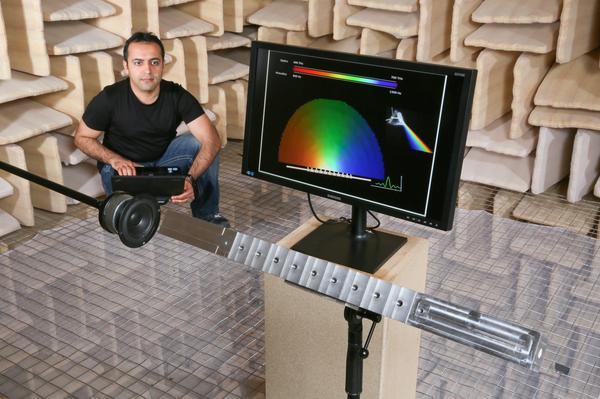Invented a very useful "acoustic prism"
A single microphone is enough to determine the angle of the “prism” to the sound source.

Herve Lissek and his invention - acoustic prism (aluminum tube with holes in the foreground)
Almost 400 years ago, young Isaac Newton discovered that a transparent prism divided white light into all the colors of the rainbow. Each color in the spectrum corresponds to a different wavelength. The optical prism uses the physical effect of the refraction of light to break white light into its components.
Now Newton has a worthy student - Hervé Lissek of the Federal Polytechnic School of Lausanne. Together with his group in the signal processing laboratory 2, he developed a “prism” for separating not light, but sound into components. Acoustic prism.
The design and possible applications of an acoustic prism are described in a scientific paper published in the Journal of the Acoustical Society of America (doi: 10.1121 / 1.4949544).
Optical prisms are widely found in nature in the form of water droplets, but the acoustic prism is a completely man-made design. This is a rectangular aluminum tube with ten carefully aligned holes on one side.
Behind each hole is a cubic cavity filled with air, and the adjacent cavities are separated from each other by membranes.

Acoustic prism design
When the sound enters the tube from one side, its high-frequency components immediately go out into the nearby holes, and the low-frequency components move further along the tube. The lower the frequency, the more sound will come out in the farther hole. As in the optical prism, the sound here is also scattered, and the scattering angle depends on the wavelength.
A key element in the design of an acoustic prism is membranes, since they vibrate and transmit sound to neighboring cavities with a delay that depends on the frequency of the sound. Actually, the “delayed” sound thus comes out through the holes, and the rest goes on.
Reflecting on his invention, Herve Lissek realized that the acoustic prism can work as an antenna, which is able to determine the direction to the sound source, simply by measuring the frequency of the scattered sound and comparing with the original. Since each scattering angle corresponds to a certain frequency, it is sufficient to measure the main frequency component with a microphone to determine at what angle the sound source is from the prism. You do not need to rotate the antenna.
The accuracy of determining the direction of sound in a stationary installation with a single microphone has been verified experimentally.

The design of the prism is quite simple. All its components are easy to make, including in a miniature size. Thus, it can be used as a cheap alternative to existing sound detection systems that involve the use of expensive microphone arrays or mobile antennas.
